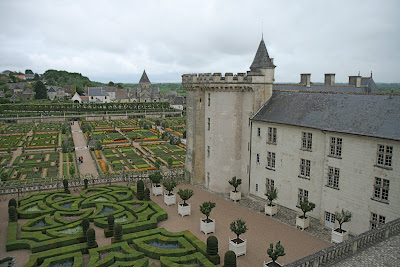
Villandry undoubtedly has the most immaculately maintained gardens in the Loire Valley. It is France’s archetypal potager--an elaborate kitchen garden--with seemingly endless parterres defined by meticulously clipped boxwood.
Grand Allée of Lime trees
The château was built in 1536 for Jean Le Breton, France's Controller-General for War and Ambassador to Italy under François I.

Moat at Château
Le Breton studied Italian Renaissance gardens while in Italy and was influenced by this in developing the gardens at Villandry.

16th Century wall
The addition of flower beds, fountains, bowers, and ornaments came particularly from his exposure to Florence.
The château remained in the Le Breton family for more than 200 years then suffered through neglect under its two subsequent ownerships and the garden was almost completely destroyed. It was rescued in 1906, by Joachim Carvallo, a Spanish-born doctor and his American wife, Ann Coleman. They poured an enormous amount of time, money and devotion into repairing the château and recreating the beautiful gardens in the Renaissance spirit.

The restoration evokes a painstaking love and deep Italian and French influences in developing the symbolism of each garden area.


Scroll detail on viewing platform
In fact, the garden is fraught with romantic symbolism, but requires some study to realize this. The garden is basically composed of three levels: the highest is Le Jardin d’Eau (the Water Garden), at the north end of the 15 acre garden. The second level, just north of the moat of the Château, Le Jardin d'Ornement, consists of the Garden of Music, the Decorative Flower Garden, the Garden of Love and the Garden of Simple Delights.


Le potager, which covers three acres itself, derives from the medieval kitchen gardens cultivated by monks and nuns in the abbeys. Tree roses were traditional in the abbey gardens and at Villandry they have been planted geometrically to represent the monks.

The crosses seen throughout the garden reflect the monastic origins of Le Potager and the rotation of more than 40 types of vegetables, are arranged by color, form and companion planting rules. Only vegetables used in the 16th century are still grown.



The agréments (features designed for pure pleasure) placed throughout the garden suggest romantic love-- for example, the gloriettas, or gazebos, that punctuate Le Potager are made from latticework formed into intimate curved shapes, with a fountain splashing softly in front of each one, that seem to beckon lovers.





Features such as the urns overflowing with vegetables and fruit symbolize the abundance of the garden.

Strolling through Le Potager, one comes upon one lovely element after the next, with even fences and arbors detailed to suggest romanticism.
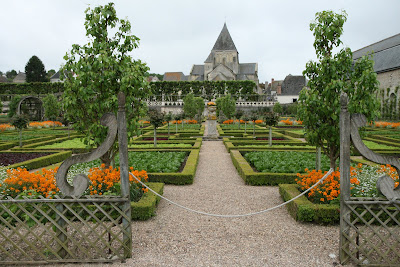


Painstakingly espaliered fruit trees line the walls in separate garden areas and climbing roses clamber over retaining walls.

The Garden of Love, which is built on a level above that of Le Potager, is absolute symbolism.

It is composed of four aspects of love expressed in carefully pruned boxwood forms: Tender Love, Passionate Love, Fickle Love and Tragic Love. In ‘Tender Love’ perfect heart-shapes of boxwood express love in its most ideal (Renaissance) form. In 'Passionate Love,' the hearts are broken in a crisscross maze. The ‘Fickle Love’ quadrant fans out the shapes to symbolize the volatility of feelings. Yellow flowering annuals--representing jilted love--are at the center of this quadrant. The last quadrant, 'Tragic Love,' is a disarray of shapes with jagged edges like daggers and the flowers within are red to symbolize the blood spilled in duels.

Le Jardin d'Ornement
Beyond the Garden of Love, are parterres with patriotic themes, like the Maltese cross, the Languedoc cross , the Basque cross and the classic fleurs de lys.
Le Jardin d’Eau contains the Florentine-influenced water gardens, which are like models of those at Versailles. The serene ponds of water are surrounded by immaculately kept lawns and softly splashing fountains.





 Grape arbor
Grape arbor




Among the romantic architectural elements at the estate are great stone walls with ballasts and L'Audience.

Manicured grass paths bordered by allées of pollarded Limes (Tilia platyphyllos) lead to Le Jardin du Soleil on the opposite side of Le Potager from the Garden of Love.

A tightly manicured arbor encloses Le Jardin du Soleil, where annuals and perennials flower continuously alongside Le Jardin d'Herbes Aromatiques. Over 30 varieties of herbs for cooking and medicinal use are grown here.

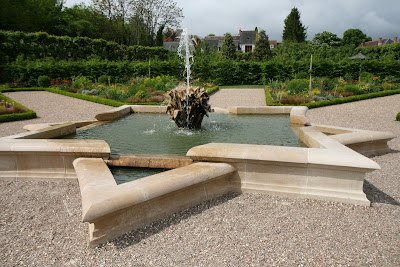
To the northeast there is a recent addition of a Renaissance style maze planted with 12,000 clipped Beech (Fagus sylvatica) trees.
Eight gardeners work full time аt Villandry under the supervision of Henri Carvallo (the great-grandson of Joachim), primping and tweaking the 45,000 annuals and 60,000 vegetables that are planted in a color-coordinated array every year and maintaining thousands of espaliered, pollarded, pleached and sheared trees and shrubs.

As an added incentive to visit Villandry (as if one were needed!), Les Nuits des Mille Feux is held in July. 2,000 candles light up the Château and gardens from sundown until after midnight and musicians stroll through the gardens playing Baroque music.
In 1924, Joachim Carvallo founded "La Demeure Historique," the first association for owners of châteaux with historical value, and ten years later Château de Villandry was designated a Monument historique*, and subsequently named by Unesco as a World Heritage Site. The success of Villandry is a testament to the strength of wealthy private ownership in preservation and restoration. There are many châteaux in France that have fallen into severe disrepair because of the destitution of their owners. In cases like Ussé, the gardens are still fairly well-maintained, but the château is crumbling while the family occupies one wing and struggles to hold onto their heritage.
* Monument historique is a State procedure in France by which heritage protection is extended because of a place’s historical importance.













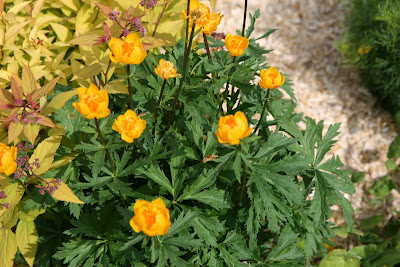

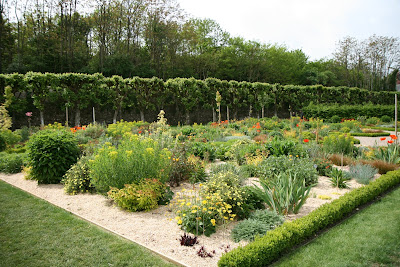




Just too beautiful for words! I have a small potager in a city lot in the midwest....those pictures humble one here in the midwest...very pretty..thank you for sharing the photos...:-) roberta
ReplyDelete